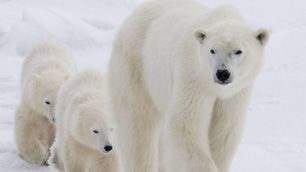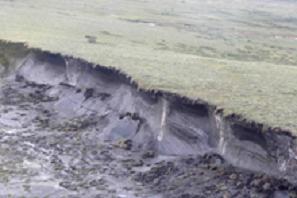Beaufort Sea polar bear population took big hit in early 2000s, study says

The polar bear population in the southern Beaufort Sea — considered one of the populations most vulnerable to reductions in Arctic sea ice — dropped by roughly 40 percent between 2001 and 2010, according to a newstudy by U.S. and Canadian scientists.
The bears fared especially poorly in the middle of the decade, according to the study, published online in the journal Ecological Applications. The population of youngest bears was most hurt, with few surviving in the years 2004 to 2006, according to the study.
“We basically had very poor cub survival and we saw very few subadult bears in the years since then,” said the lead author, Jeff Bromaghin, a USGS research statistician
‘Alarming’
The decline in adult survival, though less dramatic, was also “alarming” during that period, given that polar bears are very long-lived animals with life spans of up to 30 years, he said.
The population appears to have stabilized after 2007, though the number of subadult bears declined throughout the decade, according to the study.
In all, there were about 900 animals in the southern Beaufort Sea population in 2010, down from an estimated 1,250 to 2,000 animals in 2004, according to the study, which was based on data gathered through live capture of polar bears each spring.
Live-capture program
In that live-capture program, which continues, bears are tranquilized, marked, sampled and, in about two dozen cases a year, radio-tagged. From 2003 to 2010, biologists working along the Beaufort Sea coastline in Alaska and Canada captured roughly 200 to 400 bears a year; in the earliest years of the decade, however, the live-capture work was done only on the Alaska side. Together, the U.S. and Canadian scientists probably capture about 15 percent of the Beaufort polar bears each spring, and each returning year they find bears they marked previously.
But of the 80 polar bear cubs caught and marked from 2003 to 2007, only two were found in 2010, Bromaghin said.
The lack of Canadian data in the early part of the decade is one reason for uncertainty in the estimates, Bromaghin said. Though the authors believe the decline estimate of 40 percent is likely accurate, he said, the study establishes a range of 25 percent and 50 percent to be conservative.
Sea ice
Though the study focuses on identifying survival rates and population numbers rather than the reasons behind those statistics, cause of the decline seems apparent — reduced sea ice, he said.
“The ice is much different than it used to be,” he said.
Open water exists in areas that used to be ice-covered in spring, and the ice that exists at that time of year is thinner, he said. That means polar bears have less access to their food, he said. In some cases, the thinner ice is pushed together, creating wind-blown piles that make life difficult for polar bears, Bromaghin said.
“We saw several cases of bears clawing through really thick chunks of ice to get to seals,” he said.
Several other studies pointed to reasons for the steep decline in survival in the middle of the decade, as well as the stabilization after 2007, Bromaghin said.
There were documented trends of reduced sea ice, as referenced by the study. There was a Canadian study that found up to 25 percent of adult females with cubs — about twice as many as normal — were fasting during the spring following the winter of 2004-05, he said. There are studies indicating a scarcity of seals in the middle of the decade, followed by an increase in seal numbers later in the decade, he said. And there is a Bureau of Ocean Energy Management study that suggests the open-water leads in the Beaufort Sea ice changed after 2007, possibly helping polar bears find food, he said.
“It’s all the little lines of evidence pointing in the same direction,” he said.
Changing climate
Known for their translucent fur, their swimming and hunting prowess and their dependence on dwindling sea ice, polar bears have become icons of Arctic climate change.
Polar bears, listed in 2008 as threatened, were the first mammals granted Endangered Species Act protections because of reduced summer and fall sea ice. The southern Beaufort Sea population, one of 19 populations in the Arctic and subarctic regions, is one of the best-studied. It’s also believed to be most at risk from declining sea ice and scarcities of food. The population was in poor shape prior to the 1970s because of overhunting but passage of the Marine Mammal Protection Act of 1972 allowed the bears to recover, and the population grew until the 1990s, according to the U.S. Fish and Wildlife Service.
But the southern Beaufort Sea polar bears began to falter as population declined and the animals became smaller, with smaller skulls, according to studies by the USGS.
In the winter of 2004, polar bear expert Steven Amstrup and Ian Stirling, co-authors of the latest study, and some colleagues confirmed three instances of cannibalism among Beaufort Sea polar bears, described in a study published in 2006 in the journal Polar Biology.
Warning sign
The new study, with its estimate of a 40 percent decline over the decade, shows the dangers of climate change, environmentalists said.
“This is a clear warning sign of the impact a warming Arctic has on ice-dependent species like the polar bear,” Pete Ewins, senior species officer for the World Wildlife Fund in Canada, said in a statement. “Given this subpopulation is at the edge of the range, it’s no surprise to see this happening so soon. We need to take firm action right now to address climate change, the main threat to polar bears.”
Compared to the Beaufort population, the Chukchi Sea polar bear population appears more resilient.
A study by scientists from the Fish and Wildlife Service, the USGS and other agencies, published in January in the journal Global Change Biology, found that Chukchi Sea polar bears were bigger and more likely to reproduce successfully than their southern Beaufort Sea counterparts. The Chukchi polar bears endured only half as many days of ice scarcity, that study said.
The Chukchi Sea bears have an advantage because the shallow continental shelf is much broader, providing more area of food access, Bromaghin said. In addition, the ice is not receding as quickly there, he said.
Still, there are other potential risks for Chukchi bears. A study published last month in the journal Ecosphere by scientists from the Fish and Wildlife Service, USGS and University of Idaho found significant overlap between key Chukchi polar bear habitat and areas envisioned for offshore oil and gas development.
More than 15 percent of the oil-development planning area was high-value habitat for the Chukchi bears, the study found.
Related stories from around the North:
Canada: Star of acclaimed Inuit-language film shoots polar bear in self-defence, CBC News
Norway: Arctic Norway needs polar bear spotter, The Associated Press
Russia: Putin ensures Arctic militarization will not harm polar bears, Barents Observer
Sweden: Wild boar attack in suburb of Stockholm, Sweden, Radio Sweden
United States: Polar bears sniff pawprints to find clues about potential mates: study, Alaska Dispatch



